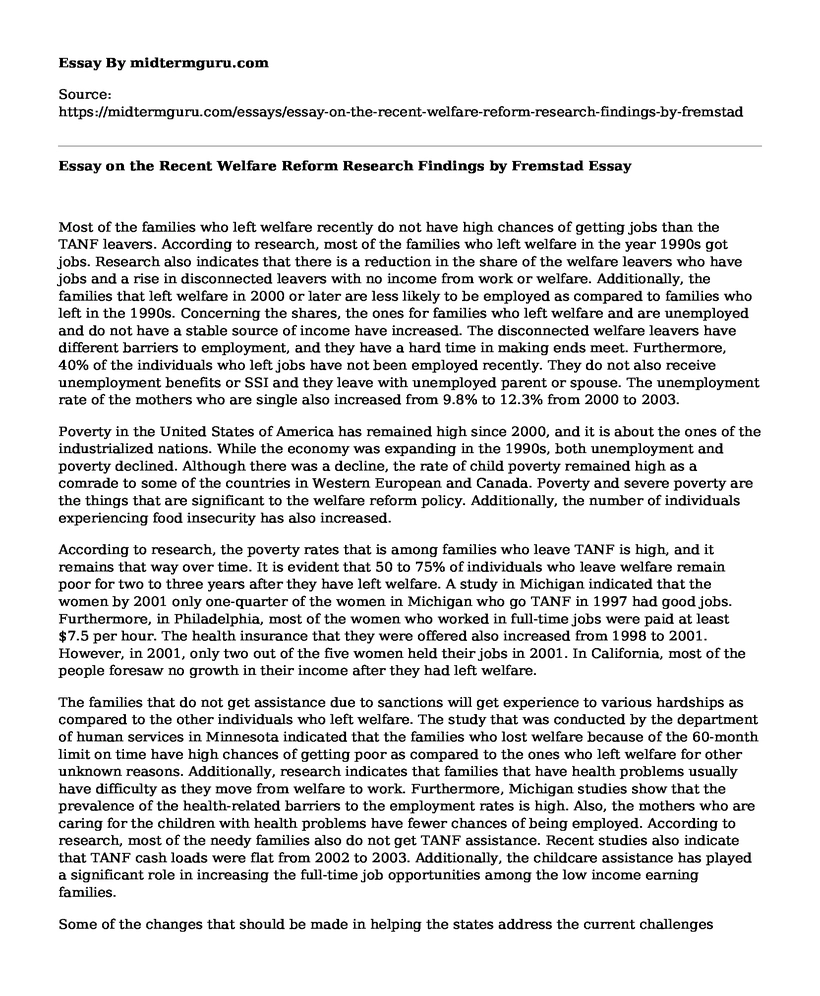Most of the families who left welfare recently do not have high chances of getting jobs than the TANF leavers. According to research, most of the families who left welfare in the year 1990s got jobs. Research also indicates that there is a reduction in the share of the welfare leavers who have jobs and a rise in disconnected leavers with no income from work or welfare. Additionally, the families that left welfare in 2000 or later are less likely to be employed as compared to families who left in the 1990s. Concerning the shares, the ones for families who left welfare and are unemployed and do not have a stable source of income have increased. The disconnected welfare leavers have different barriers to employment, and they have a hard time in making ends meet. Furthermore, 40% of the individuals who left jobs have not been employed recently. They do not also receive unemployment benefits or SSI and they leave with unemployed parent or spouse. The unemployment rate of the mothers who are single also increased from 9.8% to 12.3% from 2000 to 2003.
Poverty in the United States of America has remained high since 2000, and it is about the ones of the industrialized nations. While the economy was expanding in the 1990s, both unemployment and poverty declined. Although there was a decline, the rate of child poverty remained high as a comrade to some of the countries in Western European and Canada. Poverty and severe poverty are the things that are significant to the welfare reform policy. Additionally, the number of individuals experiencing food insecurity has also increased.
According to research, the poverty rates that is among families who leave TANF is high, and it remains that way over time. It is evident that 50 to 75% of individuals who leave welfare remain poor for two to three years after they have left welfare. A study in Michigan indicated that the women by 2001 only one-quarter of the women in Michigan who go TANF in 1997 had good jobs. Furthermore, in Philadelphia, most of the women who worked in full-time jobs were paid at least $7.5 per hour. The health insurance that they were offered also increased from 1998 to 2001. However, in 2001, only two out of the five women held their jobs in 2001. In California, most of the people foresaw no growth in their income after they had left welfare.
The families that do not get assistance due to sanctions will get experience to various hardships as compared to the other individuals who left welfare. The study that was conducted by the department of human services in Minnesota indicated that the families who lost welfare because of the 60-month limit on time have high chances of getting poor as compared to the ones who left welfare for other unknown reasons. Additionally, research indicates that families that have health problems usually have difficulty as they move from welfare to work. Furthermore, Michigan studies show that the prevalence of the health-related barriers to the employment rates is high. Also, the mothers who are caring for the children with health problems have fewer chances of being employed. According to research, most of the needy families also do not get TANF assistance. Recent studies also indicate that TANF cash loads were flat from 2002 to 2003. Additionally, the childcare assistance has played a significant role in increasing the full-time job opportunities among the low income earning families.
Some of the changes that should be made in helping the states address the current challenges include TANF recipients who have disabilities should be offered with rehabilitative services. Additionally, the Congress should play the role of proposing to fund the programs of transitional jobs. A limit on the current law that imposes education and vocational training for the TANF recipients is supposed to be lifted. There should also be a house bill, which mandates the states to adopt the issue of full family.
The different research findings offer significant lessons on the state level TANF. Most of the concerns that are raised by the current research include reduced level of participation by the families that are able and high rate of poverty. Address these issues can only if the policies of TANF are changed through states. For instance, states should try to know if some of the set policies have an impact on the needy families. Additionally, states are supposed to tailor job requirements according to the needs of families. States should also examine their time limit and consider revamping the rules of TANF.
In conclusion, according to the recent studies as evident in the research paper, the results of the welfare reform research that were conducted in the 1990s when there was a strong economic time might differ from the data collected during the time that had a weak economy. However, it is evident that the life of the individuals who left welfare has changed. Most of them earn lower income as compared to the time that they were in the welfare associations.
References
Fremstad, S. (2004). Recent welfare reform research findings: Implications for TANF reauthorization and state TANF policies. Washington, DC: Center on Budget and Policy Priorities.
Cite this page
Essay on the Recent Welfare Reform Research Findings by Fremstad. (2021, May 27). Retrieved from https://midtermguru.com/essays/essay-on-the-recent-welfare-reform-research-findings-by-fremstad
If you are the original author of this essay and no longer wish to have it published on the midtermguru.com website, please click below to request its removal:
- Analysis of the Article on the Drug Abuse - Paper Example
- Literary Analysis of The Victims by Sharon Olds - Paper Example
- Paper Example on Drugs And Substance Abuse Among Students
- Assignment Example on Ecstasy
- School Violence: Unprepared Teachers, Vulnerable Students - Research Paper
- US Women's Soccer: Unfair Remuneration and Discrimination - Essay Sample
- Male Superiority and Inferior Races: A Subjugated Reality - Essay Sample







